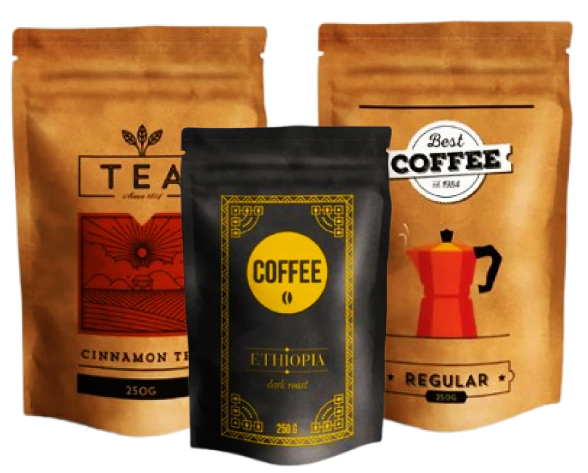Coffee Bag Packaging Template serve as essential tools for businesses looking to create custom packaging for their coffee products. These templates guide the design and layout of the packaging, ensuring that the final product meets both aesthetic and functional requirements. However, with increasing environmental concerns, the recyclability of these packaging materials has become a significant issue.
What Is A Coffee Bag Packaging Template?
Before diving into the recyclability of coffee bag packaging, it is crucial to understand what these templates are. A coffee bag packaging template is a pre-designed layout that specifies the size, shape, and design elements of a coffee bag. These templates are used by manufacturers and designers to create the actual packaging that holds the coffee beans or grounds.
Materials Used in Coffee Bag Packaging Template
To understand the recyclability of coffee bag packaging, we must first examine the materials commonly used in their production. Most coffee bags are make from a combination of materials, each serving a specific purpose.
- Paper
Paper is often use as the primary material in coffee bag packaging. It is biodegradable and, in most cases, recyclable. However, the recyclability of paper largely depends on whether it has been coat or laminate with other materials.
- Plastic
Plastic is another common material use in coffee bag packaging. It provides excellent barrier properties, protecting the coffee from moisture and oxygen. While plastic can be recyclable, the type of plastic and whether it is mix with other materials can affect its recyclability.
- Foil
Thw foil is often use as a lining inside coffee bags to further protect the contents from light and air. Foil provides a strong barrier but is usually not recyclable, especially when laminate to other materials.
The Challenge of Recycling Multi-Layered Packaging
One of the primary challenges in recycling coffee bag packaging template is the multi-layered structure. Most coffee bags are make from a combination of paper, plastic, and foil, which are laminate together to create a strong, durable package. While each of these materials might be recyclable on its own, the process of separating them in a recycling facility is often complex and not always feasible.
Are Paper-Based Coffee Bags Recyclable?
Paper-based coffee bags are generally more recyclable than their plastic or foil counterparts. However, the recyclability of these bags depends on several factors.
- Coating and Laminations
Many paper-based coffee bags are coat or laminate with a thin layer of plastic or foil to improve their barrier properties. This coating makes the paper stronger and more resistant to moisture, but it also complicates the recycling process.
- Uncoated Paper Bags
Uncoated paper coffee bags, on the other hand, are much easier to recycle. These bags can be process with other paper products and are more likely to be accept by recycling centers. However, they offer less protection for the coffee, which may affect the quality of the product.
The Role of Plastic in Coffee Bag packaging template Recycling
Plastic plays a crucial role in coffee bag packaging template due to its excellent barrier properties and durability. However, the type of plastic used and how it is combine with other materials can significantly affect its recyclability.
Single-Material Plastic Bags
Some coffee bags are make entirely of plastic, using a single type of plastic material. These bags are generally more recyclable than multi-material bags, as they can be processed like other plastic products. However, the specific type of plastic used is important. For example, bags made from polyethylene (PE) or polypropylene (PP) are more likely to be accept by recycling centers.
Multi-Material Plastic Bags
Many coffee bags are make from multiple layers of different types of plastic or a combination of plastic and other materials. These multi-material bags are much more difficult to recycle because the layers need to be separate before the plastic can be process.
Foil and Its Impact on Recyclability
Foil is often use in coffee bag packaging template to provide an additional barrier against light and air, which can degrade the quality of the coffee. However, foil is one of the least recyclable materials use in coffee bags.
- Laminated Foil
When foil is laminate to paper or plastic, it becomes almost impossible to recycle. The laminated layers are challenging to separate, and most recycling facilities do not have the capability to process these materials. As a result, laminated foil coffee bags often end up in landfills.
- Pure Foil Bags
Pure foil coffee bags are rare but do exist. These bags are more recyclable than laminated foil bags, but they still present challenges. Pure foil can be recycle, but it requires specialize facilities that are not available in all areas.
The Importance of Recycling Labels
One way to improve the recyclability of coffee bag packaging template is through clear recycling labels. These labels can inform consumers about how to dispose of the packaging properly. For example, some coffee bags may be partially recyclable, meaning that the paper component can be recycle, but the plastic or foil layers must be discarde.
Alternatives to Non-Recyclable coffee bag packaging template
Given the challenges associated with recycling traditional coffee bag packaging, some companies are exploring alternatives that are easier to recycle or that reduce environmental impact.
- Compostable Bags
Compostable coffee bags are made from materials that break down naturally in a composting environment. These bags offer a more environmentally friendly alternative to traditional packaging, as they do not require the complex recycling processes associated with multi-layered materials.
- Reusable Containers
Some coffee brands are moving towards reusable containers as an alternative to single-use coffee bags. These containers can be refilled with coffee beans or grounds, reducing the need for disposable packaging. While not a perfect solution, reusable containers can significantly reduce the amount of waste generated by coffee packaging.
Conclusion
In summary, the recyclability of coffee bag packaging template depends on several factors, including the materials used and how they are combine. While paper-based bags are generally more recyclable, coatings and laminations can complicate the process. Canadian Packaging Companies excel in delivering high-quality, sustainable packaging options that meet the diverse needs of businesses across the country.







Leave a comment
Your email address will not be published. Required fields are marked *